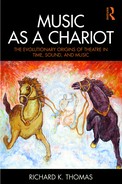Foreword
In the summer of 1988, I had just completed an undergrad degree in electrical and computer engineering at Purdue University that also included a fair amount of classwork in acoustics and music theory. I was set to start grad school in the fall, also at Purdue, to study acoustics in the School of Mechanical Engineering. But, as the summer progressed, I began to question my plans and bounced between a fascination with acoustics and engineering and a deeper desire to explore the more creative aspects of music and audio.
Tension between the analytical and the expressive, between things engineered and things created, was not entirely new to me. An influential and prescient teacher in my senior year of high school summed it up in a note on my final essay of the year: “You will always wrestle with a tug of war between the analytical and the creative.”
With summer passing and grad school approaching, I was running out of time if I was going to change course. Fortunately, I found a path forward with the help of two tremendously supportive and generous people: Stuart Bolton, my professor for acoustics and noise control, and Helen Brown, my professor for music theory and composition.
To this day, I am grateful that they supported me to expand my outlook beyond traditional engineering, which, among other things, included introducing me to Rick Thomas, a professor in Purdue’s Theatre Department. Rick encouraged me to enter his graduate sound design program and helped me through a compressed application process. That fall, I was accepted into the M.F.A. program in the Theatre Department at Purdue.
One of my first interactions with Rick reflects what I came to appreciate about him as a teacher and an artist, and also reflects one of the core ideas in this book. Rick said, “You know a lot about engineering, but we need to teach you about the human condition.”
These were inspiring words, but putting them in practice at the start of the school year was more terror than inspiration thanks to Rick, who had decided that “learning about the human condition” was best achieved by putting me—an uptight engineer—in the first-year undergraduate acting program. “Fish out of water” doesn’t begin to describe how out of place I was among actors, but fortunately my peers and professors both had an abundance of empathy and goodwill. The craft and principles that I learned with them for creating and performing art as part of a team have served me over three decades of work in technology and entertainment.
During grad school, I had the privilege to help Rick teach sound design classes, which both drew upon and built on his evolving ideas about the nature of music in theatre. The curriculum for these classes was my first exposure to the fundamental connection that Rick saw between the visual and the auditory. The idea that size in the visual world could be thought of as volume in the auditory world, that lines and shapes in physical objects could correspond to melodies and harmonies in music, that the texture and color of a surface could be thought of as the timbre and tone of an instrument—these were foundational to me.
After completing my M.F.A., my career took a direction away from the theatre, and I began working on and designing video games. It turns out that putting on a play and making a video game have more in common than one might think. Both video games and theatre seek to immerse the audience in a fabricated moment in space and time and take them on an emotional journey. Both involve working as part of a diverse and collaborative team, and both depend on harnessing technology to tell a story and captivate the viewer.
Rick would lead his students through a process of deconstruction followed by synthesis: a process of getting to the root and core of something and then exploring how its pieces could be manipulated to make something new. I believe that process is echoed in his approach to this book. We can better understand how music incites emotions and creates mood if we start with a model of how our brains process sound waves. We can better understand the role of music in any art form if we go back through time and trace the connections between music, language, stories and performance.
Today, the Theatre Department at Purdue is housed in a wonderful collection of purposeful and modern facilities. During my tenure, things were more improvised and cramped, and Rick was gracious enough to share his office with his graduate assistants. A file cabinet in the corner of that office housed Rick’s growing collection of notes and papers, many of which were my first exposure to his thinking about the connection between artist and audience and how we each uniquely experience music and theatre.
Rick continues to be a mentor and friend, and I know that he has put a career’s worth of thinking and experience into writing this book, which should speak well to sound designers, composers, musicians, directors, actors, engineers, and anyone who has ever sat in the audience of a live performance.
